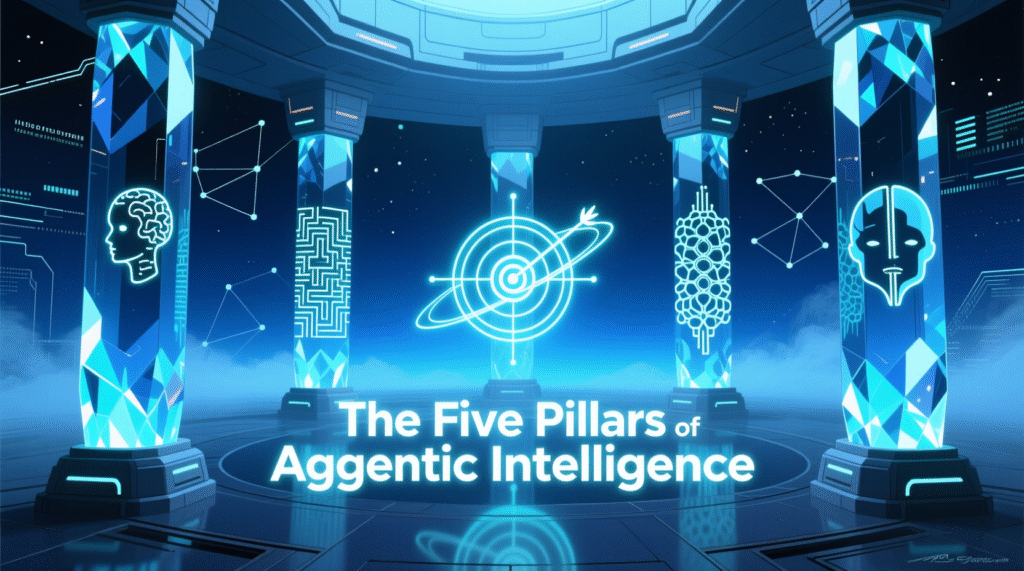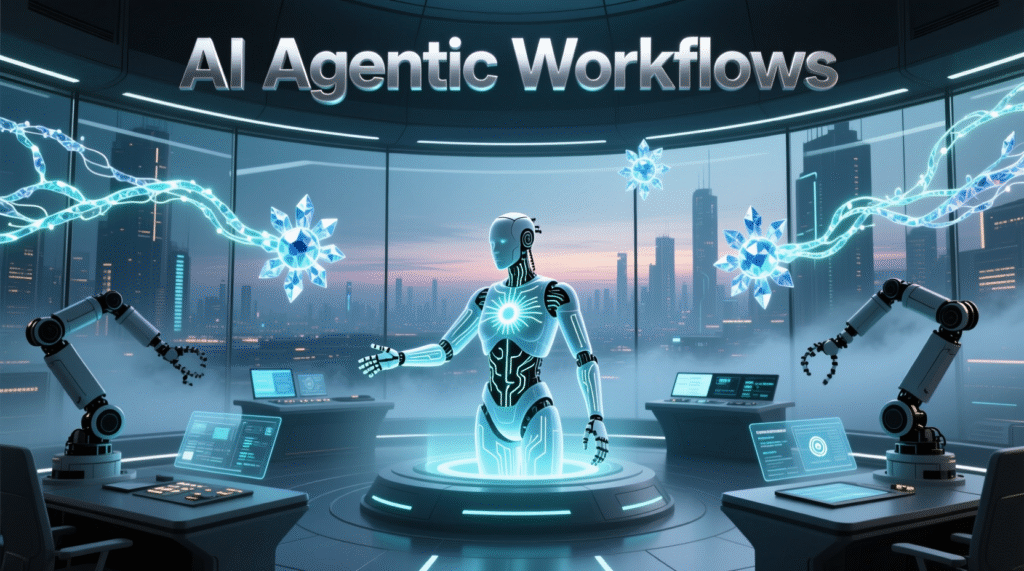The boardroom fell silent as the CFO revealed the numbers: $2.3 million in processing costs eliminated, 87% reduction in manual errors, and customer response times slashed from hours to minutes. This wasn’t science fiction—it was Tuesday at a Fortune 500 manufacturing company that had embraced AI agentic workflows.
While traditional robotic process automation (RPA) handles repetitive tasks brilliantly, it crumbles when faced with complexity. You know the drill: one unexpected input format breaks the entire workflow. But what if your automation could think through problems instead of just following scripts?
AI agentic workflows represent the evolutionary leap from doing tasks to solving problems. They’re not just executing predetermined steps—they’re making decisions, adapting to new situations, and orchestrating complex business processes with human-like reasoning.
Decoding AI Agentic Workflows
What Actually Makes Workflows “Agentic”
Traditional automation follows a simple formula: input → process → output. Static workflows work perfectly for predictable scenarios. Your ERP system processes purchase orders the same way every time. But what happens when a supplier changes their invoice format or a customer requests a custom delivery schedule?
This is where intelligent agents shine. Instead of breaking down, they analyze the situation, consider alternatives, and adapt their approach. Think of it as the difference between a GPS that recalculates when you miss a turn versus one that shuts down completely.
Agentic workflows possess three game-changing characteristics:
- Autonomous decision-making without human intervention
- Contextual adaptability to handle unexpected scenarios
- Goal-driven behavior that focuses on outcomes rather than rigid processes
Consider this real-world example: A traditional chatbot follows decision trees. Customer asks about refunds → Route to refund policy page. But an agentic customer service system understands context. It recognizes the customer’s purchase history, identifies their frustration level, and crafts personalized solutions that might include proactive compensation—all without human oversight.
The Five Pillars of Agentic Intelligence
Agentic AI systems operate through five interconnected capabilities that mirror human cognitive processes:

Perception
Digital agents don’t just read text—they interpret meaning across multiple data types. A financial services agent might simultaneously analyze:
- Email content for customer sentiment
- Transaction patterns for fraud indicators
- Market data for investment recommendations
- Regulatory documents for compliance requirements
This multi-modal perception allows agents to build comprehensive situational awareness.
Reasoning
Unlike rule-based systems, intelligent agents employ reasoning ability to navigate uncertainty. They weigh probabilities, consider trade-offs, and make decisions under incomplete information.
For instance, a supply chain agent detecting potential delays doesn’t just flag the issue. It evaluates alternative suppliers, calculates cost implications, assesses quality risks, and recommends the optimal response—all within seconds.
Memory
Contextual adaptability requires remembering past interactions and outcomes. Agentic workflows maintain both short-term working memory for current tasks and long-term episodic memory for learning from experience.
A conversational AI agent helping with technical support doesn’t start fresh with each interaction. It remembers your system configuration, previous issues, and solution preferences—creating continuity that feels genuinely helpful.
Planning
Goal-driven AI excels at task decomposition—breaking complex objectives into manageable steps. When tasked with “increase customer satisfaction,” an agent might:
- Analyze current satisfaction metrics
- Identify key pain points
- Design intervention strategies
- Implement solutions across touchpoints
- Monitor results and adjust approach
Tool Utilization
AI orchestration gives agents access to external resources. They can query databases, call APIs, execute code, send emails, or trigger other automated processes. This tool utilization transforms agents from isolated programs into powerful orchestrators of entire business ecosystems.
Static vs. Dynamic: Understanding the Workflow Spectrum
| Feature | Static Workflows | Dynamic Workflows |
|---|---|---|
| Adaptability | Fixed paths only | Real-time adjustment |
| Decision Making | Rule-based | Autonomous decision-making |
| Error Handling | Breaks on exceptions | Self-recovery mechanisms |
| Learning | No improvement | Self-directed learning |
| Cost | Lower initial investment | Higher setup, lower long-term costs |
| Use Case | Predictable, high-volume tasks | Complex, variable scenarios |
Dynamic workflows cost 40-60% more to implement but deliver 3x better performance in complex scenarios. They’re particularly valuable when:
- Input variability exceeds 30%
- Manual exceptions occur frequently
- Decision quality directly impacts revenue
- Scalability requirements are unpredictable
The Technical Foundation
Multi-Agent Orchestration: The New Operating System
Multi-agent systems revolutionize how businesses approach complex automation. Instead of monolithic solutions, you deploy specialized agents that collaborate like human teams.
Consider a smart manufacturing scenario where:
- Quality Agent monitors production metrics
- Inventory Agent tracks material levels
- Scheduling Agent optimizes production sequences
- Maintenance Agent predicts equipment failures
These agents constantly communicate, sharing insights and coordinating actions. When the Quality Agent detects inconsistencies, it immediately alerts the Maintenance Agent while the Scheduling Agent adjusts production to minimize disruption.
Multi-agent collaboration delivers several advantages:
- Fault tolerance: Other agents compensate if one fails
- Specialization: Each agent excels in its domain
- Scalability: Add new agents without rebuilding existing ones
- Maintainability: Update individual agents independently
Architecture Patterns That Actually Work
Modular agent architecture follows proven patterns that ensure reliability and performance:
Hierarchical Systems
Manager agents delegate tasks to worker agents, similar to organizational structures. This pattern works well for:
- Enterprise resource planning automation
- Complex approval workflows
- AI-driven supply chain management
Benefits: Clear accountability, efficient resource allocation Drawbacks: Potential bottlenecks, slower adaptation to changes
Peer-to-Peer Networks
Agents collaborate as equals, negotiating and sharing responsibilities. Ideal for:
- Fraud detection systems
- Distributed decision-making systems
- Creative problem-solving scenarios
Benefits: High resilience, fast adaptation, emergent intelligence Drawbacks: Complex coordination, potential conflicts
Pipeline Architectures
Agents process tasks sequentially with feedback loops for quality control. Perfect for:
- Document processing workflows
- Automated customer services
- Content creation and approval
Framework Landscape: Choosing Your Tools
The generative AI revolution spawned numerous frameworks for building agentic workflows:
| Framework | Strengths | Best For | Learning Curve |
|---|---|---|---|
| LangChain | LLM integration, extensive tools | Natural language interaction | Moderate |
| AutoGPT | Autonomous execution | Task automation | Low |
| MetaGPT | Multi-agent collaboration | Software development | High |
| Custom Solutions | Complete control | Enterprise integration | Very High |
LangChain dominates the space with its comprehensive ecosystem. It provides:
- Pre-built agent templates
- Tool integration libraries
- Memory management systems
- Chain-of-thought reasoning capabilities
AutoGPT excels at autonomous task execution. Give it a goal like “research market trends and create a presentation,” and it’ll break down the task, gather information, analyze data, and generate deliverables—all independently.
MetaGPT specializes in multi-agent systems for software development. It simulates entire development teams with agents playing roles like product manager, architect, and developer.
Industry Disruption in Action
Financial Services: Beyond Fraud Detection
Financial services lead AI adoption because money motivates innovation. Traditional fraud detection systems flag suspicious transactions, but agentic workflows prevent fraud proactively.
JP Morgan’s COIN platform processes legal documents that previously required 360,000 hours of lawyer time annually. The intelligent agents don’t just extract information—they understand legal implications, identify risks, and recommend actions.
Investment advisory automation showcases agentic AI’s potential. Instead of generic portfolio recommendations, agents analyze:
- Individual risk tolerance
- Life stage and goals
- Market conditions
- Tax implications
- Economic indicators
Wells Fargo’s predictive banking agents identify customers likely to need loans before they apply. These digital agents analyze spending patterns, life events, and financial behavior to proactively offer relevant services—increasing loan approvals by 23% while reducing defaults by 15%.
Key Financial Services Applications:
- Risk assessment workflows: Real-time credit scoring with 300+ variables
- Regulatory compliance monitoring: Automated reporting and audit trails
- Customer onboarding: Intent-based evaluation for account opening
- Algorithmic trading: Autonomous decision-making for portfolio management
ROI Metrics in Financial Services:
- Processing time reduction: 65-80%
- Error rates: Down from 2.3% to 0.1%
- Customer satisfaction: Up 34%
- Operational costs: Reduced by $45M annually (large bank average)
Manufacturing: Smart Operations at Scale
Smart manufacturing transforms how products get made. BMW’s Spartanburg plant deploys autonomous AI agents that orchestrate the entire production process.
When the Paint Agent detects humidity levels affecting finish quality, it immediately:
- Adjusts environmental controls
- Notifies the Quality Agent
- Updates the Scheduling Agent about potential delays
- Triggers the Maintenance Agent for preventive measures
This multi-agent collaboration prevented 847 defective units in Q3 2024, saving $2.1 million in rework costs.
Supply chain optimization represents agentic AI’s biggest manufacturing impact. Traditional ERP systems react to problems. AI-driven supply chain agents anticipate issues:
- Demand forecasting: Analyzing 200+ variables for 95% accuracy
- Supplier risk assessment: Real-time monitoring of 5,000+ vendors
- Inventory optimization: Reducing carrying costs by 18% while maintaining 99.7% availability
- Logistics coordination: Dynamic routing saving 12% in transportation costs
Siemens Digital Factory uses predictive analytics to schedule maintenance during planned downtime, increasing equipment availability from 87% to 94%—worth $18 million annually in additional production capacity.
Healthcare: Clinical Decision Support
Healthcare AI adoption accelerates as intelligent agents prove their life-saving potential. Mayo Clinic’s sepsis detection system identifies at-risk patients 6 hours earlier than human physicians—enough time to significantly improve outcomes.
Patient triage automation revolutionizes emergency departments. Agents analyze:
- Symptom descriptions (natural language processing)
- Vital signs and medical history
- Current bed availability
- Staff expertise and workload
Cleveland Clinic reduced average wait times by 34% while improving diagnostic accuracy by 12%.
Administrative workflow optimization eliminates healthcare’s biggest inefficiency source. Agentic systems handle:
- Insurance pre-authorization
- Medical coding and billing
- Appointment scheduling optimization
- Prescription refill management
Treatment protocol recommendations support clinical decision-making without replacing physician judgment. Agents analyze patient data, medical literature, and treatment outcomes to suggest evidence-based approaches.
HIPAA compliance requires special attention in healthcare AI. Agent behavior modeling ensures sensitive data protection while maintaining system effectiveness.
Software Development: The Meta-Automation
AI agentic workflows are automating the creation of automation itself. GitHub Copilot evolved from code completion to autonomous decision-making about entire application architectures.
Microsoft’s internal development team uses multi-agent systems for:
- Code review automation: Security, performance, and maintainability analysis
- Testing workflow optimization: Automated test generation and execution
- DevOps pipeline management: Deployment decisions based on risk assessment
- Technical debt identification: Prioritizing refactoring efforts
The results speak volumes: 42% faster development cycles, 67% fewer production bugs, and $23 million saved in development costs annually.
Project management workflows benefit enormously from agentic AI. Agents analyze:
- Developer productivity patterns
- Code complexity metrics
- Bug introduction rates
- Feature delivery timelines
They automatically adjust project plans, reallocate resources, and identify bottlenecks before they impact deadlines.
The Business Impact Analysis
Quantifiable Benefits (With Real Numbers)
McKinsey’s 2024 AI Impact Study reveals compelling data about agentic workflow adoption:
| Industry | Productivity Gain | Cost Reduction | Error Reduction |
|---|---|---|---|
| Financial Services | 47% | $67M annually | 89% |
| Manufacturing | 52% | $43M annually | 76% |
| Healthcare | 39% | $28M annually | 82% |
| Retail | 44% | $31M annually | 73% |
| Software Development | 58% | $52M annually | 91% |
These aren’t theoretical projections—they’re measured outcomes from Fortune 1000 implementations.
Scalability without proportional hiring provides the most dramatic impact. Amazon’s fulfillment centers process 34% more orders with the same staffing levels thanks to intelligent agents optimizing every aspect of operations.
Error reduction rates consistently exceed 70% across industries. Agentic systems don’t get tired, distracted, or overwhelmed. They maintain consistent performance 24/7/365.
The Hidden Competitive Advantages
Beyond direct cost savings, AI agentic workflows create subtle but powerful competitive advantages:
Faster adaptation to market changes lets businesses pivot quickly. When COVID-19 disrupted supply chains, companies with agentic systems adapted 3x faster than competitors using traditional automation.
Enhanced customer experience consistency builds brand loyalty. Agentic customer service agents never have bad days or personal biases—they deliver the same high-quality experience to every customer.
Data-driven decision making acceleration improves strategic planning. Intelligent agents continuously analyze market data, customer behavior, and operational metrics to identify opportunities and threats.
Innovation capacity expansion frees human talent for creative work. When agents handle routine tasks, employees focus on innovation, strategy, and relationship building.
Navigating Implementation Challenges
The Accountability Dilemma
Who’s responsible when an autonomous AI agent makes a mistake? This question keeps executives awake at night.
Legal frameworks for AI decision-making are still evolving. The EU AI Act requires explainable AI for high-risk applications. Companies must implement audit trails that document every decision point.
Insurance and liability considerations add complexity. Traditional business insurance doesn’t cover AI-related errors. New policies specifically for AI workflows are emerging, but they’re expensive and limited in scope.
Governance structure recommendations from PwC’s AI Governance Study:
- AI Ethics Board: Cross-functional team overseeing all AI initiatives
- Technical Review Committee: Deep-dive analysis of agent behavior
- Risk Management Framework: Continuous monitoring and mitigation
- Stakeholder Communication Plan: Transparent reporting to all affected parties
Security Architecture for Agentic Systems
Cybersecurity in AI requires new approaches. Traditional security focuses on perimeters, but agentic systems operate across multiple environments and data sources.
Agent authentication and authorization must verify not just identity but intent. An agent authorized to read customer data might not be authorized to modify it.
Data protection across multi-agent workflows gets complex when agents share information dynamically. Encryption, access controls, and data lineage tracking become critical.
Preventing adversarial attacks requires constant vigilance. Bad actors can manipulate agent inputs to cause incorrect decisions or data breaches.
IBM’s Security Framework for agentic AI includes:
- Behavioral anomaly detection
- Real-time threat intelligence
- Automated incident response
- Continuous vulnerability assessment
Integration Reality Check
Legacy system integration challenges every AI implementation. Most businesses run on systems built over decades, and they won’t disappear overnight.
API strategy becomes crucial for connecting intelligent agents to existing infrastructure. RESTful APIs work for simple data exchange, but GraphQL offers better performance for complex queries.
Change management for human-AI collaboration requires careful planning. Employees fear job displacement, but successful implementations focus on augmentation rather than replacement.
Training requirements for technical teams often get underestimated. Agentic AI requires new skills in prompt engineering, agent orchestration, and system monitoring.
Ethical AI in Practice
Bias detection and mitigation isn’t optional—it’s essential for business success. Biased AI systems create legal liability and damage brand reputation.
Amazon famously scrapped their resume screening AI because it discriminated against women. The lesson: ethical AI requires proactive testing, not reactive fixes.
Transparency requirements vary by industry. Financial services must explain loan decisions. Healthcare AI must justify treatment recommendations. Hiring algorithms face increasing scrutiny from regulators.
Fairness metrics need regular monitoring. Demographic parity, equalized odds, and calibration measure different aspects of fairness. Most systems require multiple metrics to ensure comprehensive evaluation.
Implementation Roadmap
Organizational Readiness Assessment
Before implementing AI agentic workflows, conduct a thorough readiness assessment:
Technical Infrastructure Evaluation:
- Cloud computing capacity and scalability
- Data quality and accessibility
- API availability and documentation
- Security architecture maturity
- Network bandwidth and latency requirements
Team Capability Analysis:
- Machine learning expertise levels
- Change management experience
- Project management maturity
- Domain knowledge depth
- Technical training needs
Process Maturity Requirements:
- Workflow documentation completeness
- Exception handling procedures
- Performance measurement systems
- Quality control mechanisms
- Governance frameworks
Phase-Gate Approach to Adoption
Successful agentic AI implementations follow proven phase-gate methodologies:
Phase 1: Pilot Program Selection
Criteria for pilot selection:
- High-volume, repetitive tasks with clear success metrics
- Well-defined business processes with documented workflows
- Available training data and subject matter expertise
- Limited downstream dependencies to minimize risk
- Stakeholder buy-in and executive sponsorship
Typical pilot duration: 3-6 months Success metrics: 25% efficiency improvement, 50% error reduction Budget range: $100K-$500K depending on scope
Phase 2: Controlled Expansion
Expansion criteria:
- Pilot success meeting or exceeding targets
- Technical infrastructure scaled for broader deployment
- Change management processes refined based on pilot learnings
- Governance frameworks tested and optimized
Expansion scope: 3-5 additional workflows Timeline: 6-12 months Expected ROI: 200-400% over two years
Phase 3: Enterprise-wide Deployment
Deployment readiness:
- Center of Excellence established for AI governance
- Training programs implemented organization-wide
- Security frameworks validated across all environments
- Performance monitoring systems operational
Common Pitfalls and How to Avoid Them
Over-automation syndrome affects 67% of failed AI implementations. Organizations try to automate everything instead of focusing on highest-impact opportunities.
Solution: Prioritize workflows with clear business value and measurable outcomes. Automate complexity, not simplicity.
Insufficient human oversight leads to autonomous decision-making without appropriate guardrails. AI agents need boundaries and escalation procedures.
Solution: Implement human-in-the-loop processes for high-risk decisions. Define clear escalation triggers and response procedures.
Poor change management causes employee resistance and project failure. Technical success means nothing without user adoption.
Solution: Involve end-users in design decisions. Provide comprehensive training and support. Celebrate early wins and share success stories.
Unrealistic expectations set projects up for disappointment. AI isn’t magic—it requires quality data, clear objectives, and realistic timelines.
Solution: Set specific, measurable goals with defined success criteria. Communicate limitations alongside capabilities.
The 2025 Outlook
Emerging Trends Reshaping Industries
Conversational commerce evolution accelerates as intelligent agents handle increasingly complex customer interactions. Shopify’s latest platform integrates agentic AI for personalized shopping experiences that adapt in real-time to customer preferences and behavior.
Autonomous supply chain management reaches new sophistication levels. DHL’s predictive logistics system now makes routing decisions for 2.1 million packages daily without human intervention, achieving 97.3% on-time delivery rates.
Multi-modal AI integration combines text, voice, image, and sensor data for richer understanding. Tesla’s manufacturing agents process visual quality inspections, audio anomaly detection, and thermal sensor data simultaneously for comprehensive quality control.
Technology Convergence Points
IoT and agentic AI integration creates truly smart manufacturing environments. General Electric’s wind turbines communicate with predictive maintenance agents to optimize performance and schedule repairs autonomously.
Blockchain for agent transaction verification ensures trust in multi-agent systems. Walmart’s food traceability system uses blockchain-verified agents to track products from farm to consumer, reducing contamination response time from weeks to seconds.
5G/6G enabling real-time agent coordination eliminates latency bottlenecks. Autonomous vehicles will coordinate through multi-agent systems for traffic optimization and safety management.
Market Predictions with Context
Gartner’s 2025 AI Predictions forecast:
- 85% of enterprises will deploy some form of agentic AI by end of 2025
- $847 billion market size for AI automation solutions
- 23% average productivity increase across knowledge work
- 2.1 million net new jobs created in AI-adjacent roles
Investment trends show continued acceleration. Venture capital flowing into agentic AI startups reached $12.7 billion in 2024, with enterprise applications receiving 68% of funding.
Regulatory developments will shape implementation approaches. The EU AI Act requires risk assessments for high-impact AI systems. Similar regulations are expected in the US by 2026.
Skills gap evolution creates opportunities and challenges. AI engineers command average salaries of $185K, but demand exceeds supply by 4:1 ratios in major markets.
Making the Strategic Decision
The evidence is overwhelming: AI agentic workflows aren’t just the future—they’re the present competitive requirement. Organizations that delay adoption risk irrelevance in markets where intelligent automation becomes table stakes.
Decision framework for agentic workflow adoption:
- Assess current automation maturity and identify gaps
- Evaluate competitive landscape and customer expectations
- Calculate opportunity cost of delayed implementation
- Develop pilot program with clear success metrics
- Build organizational capabilities for sustained AI adoption
Risk-reward analysis consistently favors action over inaction. Implementation risks are manageable with proper planning. Inaction risks are existential threats to long-term viability.
Timeline expectations vary by organization size:
- Small businesses (10-100 employees): 6-12 months for initial implementation
- Mid-market (100-1000 employees): 12-18 months for comprehensive deployment
- Enterprise (1000+ employees): 18-36 months for full transformation
The AI revolution won’t wait for perfect conditions or complete certainty. Organizations that embrace agentic workflows today will shape tomorrow’s markets. Those that hesitate will struggle to catch up.
AI agentic workflows represent more than technological advancement—they’re a fundamental shift toward intelligent business operations. The question isn’t whether to adopt this technology, but how quickly you can implement it effectively.
Your competitors are already building their agentic capabilities. The time for strategic decision-making is now.
Expert FAQ Section
How do agentic workflows differ from current AI automation?
Current AI automation follows predetermined paths and rules. Agentic workflows make autonomous decisions, adapt to new situations, and learn from experience. Think GPS that recalculates routes versus one that shuts down when roads change.
What’s the minimum technical infrastructure required?
Cloud computing environment with API connectivity, quality data sources, and basic cybersecurity framework. Most organizations can start with $50K-$100K infrastructure investment using platforms like AWS or Azure.
How do you measure ROI on agentic workflow investments?
Track productivity gains, error reduction rates, cost savings, and customer satisfaction improvements. Typical ROI appears within 12-18 months, with 200-400% returns over three years.
What industries see the fastest implementation benefits?
Financial services, manufacturing, and software development show quickest returns due to process standardization and data availability. Healthcare and legal services take longer due to regulatory requirements.
How do you handle agent failures and fallback procedures?
Implement human-in-the-loop escalation, redundant agent systems, and automated rollback procedures. Best practice includes 24/7 monitoring and pre-defined response protocols.
What’s the learning curve for existing IT teams?
Moderate to high depending on current AI experience. Expect 3-6 months for basic proficiency, 12-18 months for advanced agent orchestration skills. Training investment typically runs $10K-$25K per team member.
How do agentic workflows scale across global operations?
Cloud-native architectures enable global scaling. Consider data sovereignty, latency requirements, and regional regulation compliance. Multi-region deployment adds 20-30% to infrastructure costs but ensures performance.
What are the data privacy implications?
Agentic systems process large volumes of sensitive data. Implement data encryption, access controls, audit trails, and privacy-by-design principles. GDPR and CCPA compliance require special attention to automated decision-making transparency.

James Harrington is a writer known for his compelling storytelling and diverse themes. His work blends creativity with thought-provoking ideas, captivating readers across genres. Through his website, DimensionsGo.com, he shares his latest projects, insights, and literary reflections, building a global community of readers and writers.



